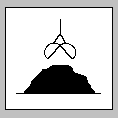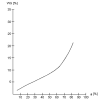| Peas, dried | [German version] |
Table of contents |
|
| General: | ||
| Product information | ||
| Packaging | ||
| Transport | ||
| Container transport | ||
| Cargo securing | ||
Product information
Product name
| German | Erbsen, getrocknet |
| English | Peas, dried |
| French | Pois séchés |
| Spanish | Guisantes |
| Scientific | Pisum sativum |
| CN/HS number * | 0713 10 ff. |
(* EU Combined Nomenclature/Harmonized System)
Product description
Peas are the seeds of the annual pea plant belonging to the legume family (Leguminosae) and are transported in dry form, i.e. dried peas are peas which have fully ripened in the pod on the plant. They are mainly garden peas of a yellow or green color. Marrowfat peas are not suitable as dried peas because they do not become soft.
Pea plants are among the oldest cultivated plants. Peas are 4.0 – 7.5 mm in diameter.
Quality / Duration of storage
A certificate of origin and health should be demanded in order to establish the quality of the peas.
Exposure to sunlight may change the normally yellow-green color of dried peas to pale gray.
Grain admixtures are admissible up to an amount of 5%.
It is very important for the surveyor to ascertain the year of harvest: it must be taken into consideration that the peas may be mixed with peas from the previous year’s harvest.
The maximum admissible admixture content is 1%, of which at most 0.5% is harmful (i.e. contamination by soil, small stones, seeds from other crop plants and weeds, empty legume husks, grain admixtures, legumes chewed and punctured by pests and crushed legumes).
Dried peas have a storage life of approx. 1 year.
Intended use
Dried peas have a high content of starch (25 – 60%) and protein (22 – 35%) and are thus a valuable foodstuff.
Peas are primarily used as a staple in stews, soups, creamed peas, ground peas and pea rissoles.
Figures
(Click on the individual Figures to enlarge them.)
 Figure 1 |
 Figure 2 |
Countries of origin
This Table shows only a selection of the most important countries of origin and should not be thought of as exhaustive.
| Europe | Czech Republic, France, Netherlands, Baltic states, Hungary, Belgium |
| Africa | Morocco, East Africa |
| Asia | |
| America | Canada, Chile |
| Australia | Australia |
Back to beginning
Packaging
Beans are packaged in, among other things, jute fabric bags (50 – 100 kg) and in cartons, in which case the beans are heat-sealed in film bags, but are also carried as bulk cargo.
When packaged in corrugated or millboard cartons, the product should be transported on pallets. The packaging size should be so selected that the dimensions of the individual area modules or area module multiples are conformed to the conventional pallet sizes (800×1200 mm and 1000×1200 mm) and cargo units may thus be produced.
 Figure 3 |
Back to beginning
Transport
Symbols
 General cargo |
 Bulk cargo |
Means of transport
Ship, truck, railroad
Container transport
Passively ventilated containers (coffee containers) subject to compliance with lower limits for water content of goods, packaging and container flooring.
Cargo handling
In damp weather (rain, snow), the cargo must be protected from moisture, since this may lead to mold, spoilage and self-heating.
Hooks must not be used in handling bagged goods as they subject the bags to point loads, so damaging them. Due to their shape, plate or bag hooks apply an area load and are thus more suitable for handling bags.
Stowage factor
| 1.22 m³/t (jute fabric bags, 50 kg) [1] | |
| 1.45 – 1.75 m³/t (bags) [11] | |
| 1.28 – 1.39 m³/t (bulk cargo) [11] | |
| 2.03 m³/t (cartons) [11] |
Stowage space requirements
Cool, dry, good ventilation
Segregation
Matting, jute coverings, fiber rope, thin fiber nets
Cargo securing
In order to ensure safe transport, the packages must be stowed and secured in the means of transport in such a manner that they cannot slip or shift during transport. If loss of volume and degradation of quality are to be avoided, the packages must not be damaged by other articles or items of cargo.
Back to beginning
Risk factors and loss prevention
RF Temperature
Peas require particular temperature, humidity/moisture and ventilation conditions (SC VII) (storage climate conditions).
Favorable travel temperature range: 5 – 25°C [1]
Dried peas should not be stowed near heat sources (engine room bulkhead, heated tanks) in order to reduce the risk of self-heating.
Drying-out and heat harden the pea husks.
Back to beginning
RF Humidity/Moisture
Peas require particular temperature, humidity/moisture and ventilation conditions (SC VII) (storage climate conditions).
| Designation | Humidity/water content | Source |
| Relative humidity | 65% | [1] |
| Water content | 14 – 16% | [1] |
| Maximum equilibrium moisture content | 65% | [1] |
The goods are strongly hygroscopic. Dried peas must therefore be protected from exposure to any kind of moisture (seawater, rain, condensation water) as there is otherwise a risk of mold, fermentation, mustiness and self-heating.
The sorption isotherm shows that, at a water content of 15%, peas reach an equilibrium moisture content of 70%. The mold growth threshold (equilibrium moisture content 75%) is reached at a water content of 17%.
 Figure 4 |
Sodden packages must be rejected.
Where ventilation is inadequate, especially at water contents > 16%, heat and moisture result in a tendency towards self-heating and rapid germination during extended voyages.
Back to beginning
RF Ventilation
Peas require particular temperature, humidity/moisture and ventilation conditions (SC VII) (storage climate conditions).
Recommended ventilation conditions: air exchange rate: at least 10 changes/hour (airing)
Where ventilation is inadequate, especially at water contents > 16%, heat and moisture result in a tendency towards self-heating and rapid germination during extended voyages.
Back to beginning
RF Biotic activity
Peas display 2nd order biotic activity.
They are living organs in which respiration processes predominate, because their supply of new nutrients has been cut off by separation from the parent plant.
Back to beginning
RF Gases
As a consequence of the respiration processes which continue after harvest, dried peas produce ripening gases (particularly CO2), which may lead to the build-up of life-threatening CO2 concentrations in the hold.
Back to beginning
RF Self-heating / Spontaneous combustion
Oil content: 1 – 3% [1]
Where ventilation is inadequate, especially at water contents > 16%, heat and moisture result in a tendency towards self-heating. For this reason, the cargo should not be stowed near heat sources.
Back to beginning
RF Odor
| Active behavior | Peas have a slight, unpleasant odor, which is typical of legumes. They must not smell musty. |
| Passive behavior | Any foreign odors are very readily absorbed by peas and are difficult to remove. |
Back to beginning
RF Contamination
| Active behavior | Peas do not cause contamination. |
| Passive behavior | Dried peas are sensitive to dust, dirt, fats and oils. |
Back to beginning
RF Mechanical influences
The packages must be secured appropriately in the hold or container so that they cannot move during transport. In the case of container transport, it is also important for the goods to be secured in the door area so that they cannot fall out of the container when the doors are opened.
Point loads applied for example by hooks may result in damage (tears) to the bags and thus to losses of volume. Plate or bag hooks, which, due to their shape, distribute the load and reduce the risk of damage, should thus be used.
Back to beginning
RF Toxicity / Hazards to health
Respiration, especially of moistened peas, may cause life-threatening CO2 concentrations (TLV: 0.49 vol.%) or O2 shortages in the hold/container. Therefore, before anybody enters the hold, it must be ventilated and a gas measurement carried out.
Back to beginning
RF Shrinkage/Shortage
Weight loss may amount to 2% due to drying-out and insect infestation. Losses of volume frequently occur due to the use of excessively weak bag material.
Back to beginning
RF Insect infestation / Diseases
Legumes are at particular risk from various species of beetles (pea beetle and lentil bruchid).
Pea beetles and lentil bruchids are field pests, i.e. they infest the good before loading and require no fumigation because they do not reproduce in the peas; they do, however, cause depreciation by contamination.
 Figure 5 |
Moth infestation, on the other hand, does require fumigation. The timing of infestation may be determined from the size of the imagos and stage of development. A fumigation certificate is necessary.
Back to beginning
